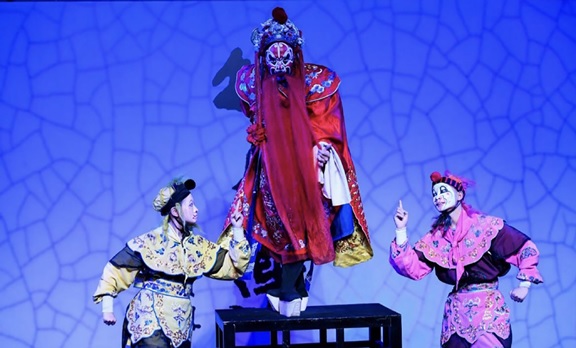
In the campus version of The Peony Pavilion, all the characters are performed by students who have learned the opera for months. [Photo provided to China Daily]
Kunqu, that grandest of all Chinese opera forms, has every intention of sticking around for many years to come, despite the fears for its future that many have often voiced.
Zhang Miao, 22, a fresh Chinese language and literature graduate student at Peking University, became a recent convert to Kunqu -- and her passion for it augurs well for the efforts being made to promote learning and teaching about it at universities. In August, she received an admission letter from the School of Arts at Peking University.
Zhang, from Anhui province, first became acquainted with Kunqu Opera four years ago when she was a first-year student at the university and joined its Kunqu Club. She also enrolled in a course called Appreciation of Classic Kunqu Opera and took a role in the campus version of The Peony Pavilion, written by Tang Xianzu (1550-1616).
She became so enamored with opera that she eventually decided to change her field of study. She plans to research the performance of opera during her postgraduate study.
The appreciation class and the performance Zhang took part in are central to an all-out government effort to promote the learning and teaching of Kunqu Opera in universities.
On July 10, Tongji University and the Shanghai Kunqu Opera Troupe initiated a new project to recruit students of universities and high schools in Yangtze River Delta to learn and perform the student version of the Hall of Longevity. The project started in August and experienced performers from the troupe will be the tutors.
Kunqu is one of the oldest types of operas in China, dating back to the Ming Dynasty (1368-1644). It combines singing, dancing, gestures and poetry recital, but the verse is delivered in archaic language made all the more difficult to grasp because it is in a southern dialect. As charming as that may be, it puts the opera out of reach for most people, which probably helps explain the broad indifference that has helped sow its slow decline since the 18th century.
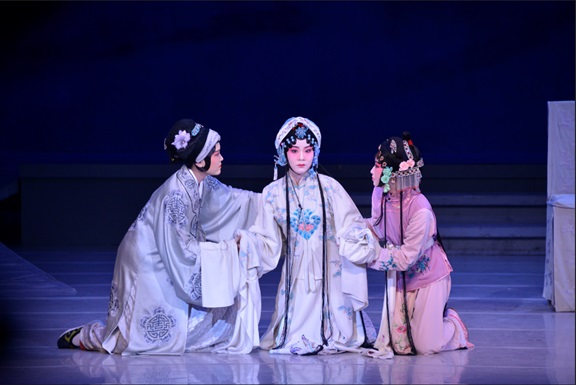
In the campus version of The Peony Pavilion, all the characters are performed by students who have learned the opera for months. [Photo provided to China Daily]
However, that has not prevented it from being dubbed a Masterpiece of the Oral and Intangible Heritage in 2001. Indeed, in the past few years its flagging fortunes seem to have changed.
That revival can be attributed in no small part to the popularity of the youth version of The Peony Pavilion adapted by Bai Xianyong, one of the most famous modern Chinese writers, who was a devotee of Kunqu Opera from an early age.
"The opera is so beautiful, with performers' graceful hand movementsandelegant gestures enhanced by long silk sleeves and poetic recitation," Zhang said.
"The melodious singing is the most fascinating part."
In The Peony Pavilion Zhang played a netherworld goblin in a part titled "Hell". Performing the role helped her to think further about the storyline and the function of each part in the drama, she said.
"It was while I was learning all this that I made up my mind to make opera a field for further study."
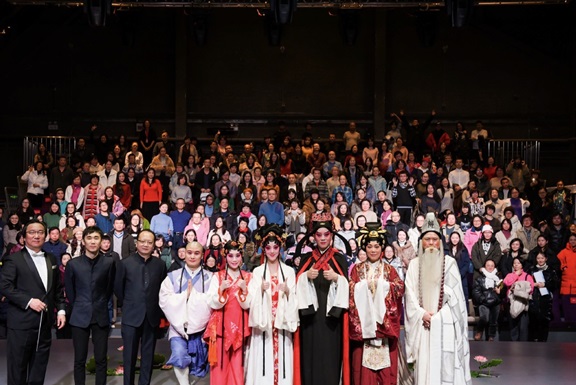
Performers take photos together with the audience at Langyuan Vintage Creative Art Zone after the Kunqu Opera Romance of the Western Chamber. [Photo provided to China Daily]
Starting from school
Chen Jun, associate professor in the School of Arts at Peking University and deputy director of the Chinese Ministry of Education Designated Inheritance Base for Outstanding Traditional Culture (Kunqu Opera), said that when the play was introduced to Peking University 15 years ago, a joke that made rounds on the campus claimed there were two distinct types of students: those who had seen the opera and those who hadn't.
In 2008, to help students better understand the opera, the university started the Appreciation of Classic Kunqu Opera course, in addition to hands-on workshops. Experienced performers around China were invited to deliver lectures and to teach the performance style in workshops.
The class would become one of the university's most popular – in fact, so popular that, according to Zhang, those who arrived early for a lesson would have to stand at the back of the classroom for the 90-minute session.
Chen, who teaches the class, said that in recent years it has had between 200 and 500 regular students.
"In fact there was a time when we had more than 600 students in attendance."
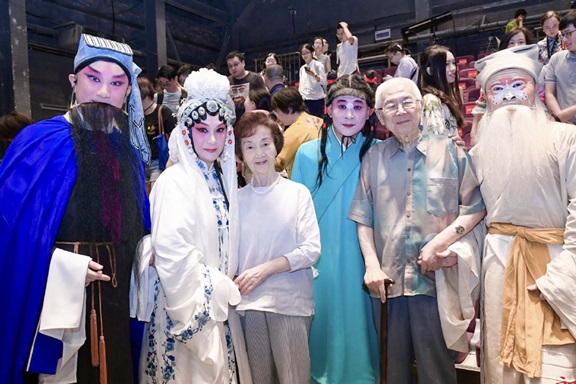
Performers with the famous Kunqu Opera actress Shen Shihua and scholar Niu Biao at Langyuan Vintage Creative Art Zone. [Photo provided to China Daily]
Apart from organizing many activities related to Kunqu Opera at the university, Chen and his colleagues have a WeChat official account called Kunqu Base that disseminates news and information about the art form.
During the COVID-19 outbreak, when theaters were closed and troupes stopped working, Chen and his colleagues contacted more than 125 people in Kunqu Opera, including past and present performers as well as academics, and they interviewed them about their lives and work during the pandemic.
In all, 29 articles under the series "Kunqu Opera During the Pandemic" were published, receiving more than 38,000 views.
About 75 percent of the readers were aged 18 to 45, figures from the WeChat official account platform show, underlying how great a pull Kunqu Opera is having on young people. Promotion of the art form at Peking University and other universities has undoubtedly played a key role in this healthy state of affairs, as have performances and lectures held at institutions such as the National Library of China and the National Center for the Performing Arts.
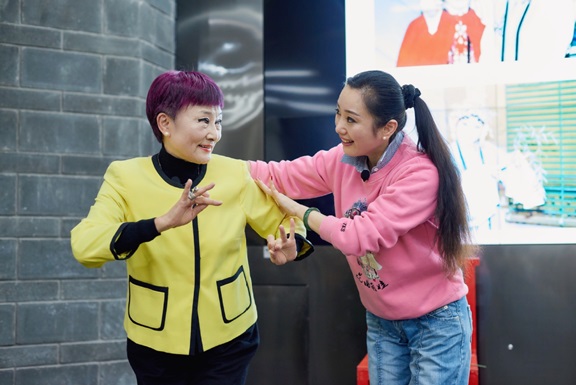
Zhang Xunpeng (left), a famous Kunqu Opera performer, is deliverling a lecture of Kunqu Opera at Peking University. [Photo provided to China Daily]
Support of society
Ding Mingzhi, who runs the Langyuan Vintage Creative Art Zone in the central business district of Beijing and puts on Kunqu Opera performances, said the average age of those who see them is 32, with 60 percent of them being female and 95 percent with bachelor degrees.
Since 2017, Ding has managed eight Kunqu Opera pieces in the art zone every year. For each performance the 200-seat theater is sold out, and sometimes, by audience request, he adds a few seats. He also organizes lectures on Kunqu Opera.
"The idea is to build the Kunqu cultural brand through these activities," Ding said.
During the pandemic, with all offline activities on hold, Ding used livestreaming to organize competitions among fans who could sing Kunqu Opera. He invited Kunqu performers to evaluate the fans' performances and give them tips on how they could improve. The competition attracted about 660 fansto participateand more than 6,000 peopleto watch. Online lectures were also held.
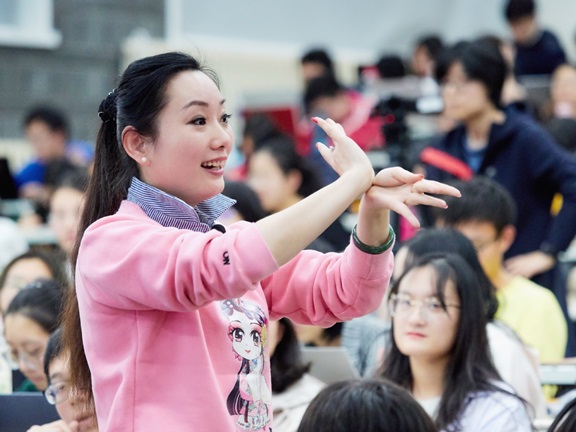
Zhao Jinyu, a promoter of Kunqu Opera in Shanghai, is teaching students gestures of Kunqu Opera at Peking University. [Photo provided to China Daily]
Another theater that draws a fairly young audience is the Northern Kunqu Opera Theatre in Beijing, which said 90 percent of the audiences for its new series are people under 45 years of age.
During the pandemic,one of its directors, Zhang Peng, and one of its main actors, Shao Tianshuai, pondered how they could make the opera more attractive to young people through the use of new media.
"Our audience members in Beijing were not allowed to come into the theater, so we decided to use livestreaming platforms," Zhang said. "By that I mean not relying on recorded videos but rather using cinematic techniques to show more details, such as micro-expressions and the performers' movement of fingers only visible to those in the front row of a theater."
The team shot a 30-minute cinematic video of The River Watching Pavilion in late May and it premiered online on June 12, with the background to the story as well as an introduction to Kunqu Opera.
Audience members posted their questions and interacted with each other through the platform, which recorded 2.66 million views for the program.
Source: China Daily





